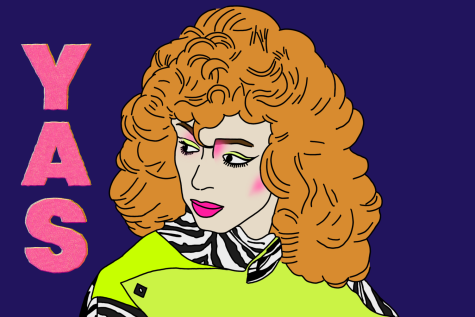
Understand the origins of ‘slay’ before using it in your vocabulary
Words like “yas,” “king” and “slay” originated in the ballroom scene, an urban subculture made up of Black and brown, queer and trans folk who found community in performing.
April 18, 2023
“Slay.”
There are a few folks in my life that code-switch when having conversations with me. They’ll throw in the words “yas,” “king” or “periodt” into almost every other sentence directed to me. They turn around to their cis-hetero friends and suddenly those words are out of their vocabulary. I always seem to brush it off, but these interactions are something I’ve taken note of. Are they microaggressions? It might be. No — it’s larger than me.
“Slay.”
These words are something I’ve become accustomed to through LGBTQ+ media and I’ve noticed their increased use in day-to-day conversations between people outside of the community, especially among younger generations on social media.
I’m not sure if I enjoy or dislike it, though. Of course, I love that queer culture is seeping into the mainstream and is becoming more accepted, but is it considered cultural appropriation if people don’t acknowledge where this vocabulary comes from?
I mean, for me, I never really made the connection until reading “All Boys Aren’t Blue,” a memoir by George M. Johnson, a queer and Black journalist.
“Slay.”
In old English, it means to kill or murder. You know, “slay the dragon.”
In the modern context, slay has become a term that people use as praise. According to Urban Dictionary, the most popular definition of slay is “killed it. succeeded in something amazing.” The definitions following it are similar.
The meaning wasn’t too different 50 years ago, but it was primarily used in a subculture known as ballroom. No, it’s not the ballroom where you wear your fanciest attire and your nicest pearls. This was underground ballroom.
Ballroom was a place that became a sanctuary for queer people of color, according to a study by UC San Francisco’s Emily Arnold in Journal of Gay & Lesbian Social Services.
When queer youth of color had nothing, ballroom became their community, their family and their home. They would be adopted into “houses” by mothers and fathers. The parent’s “main purpose is to organize elaborate balls and to provide support for their children to compete in balls as well as to survive in society as marginalized members of their communities of origin,” Arnold wrote.
If you’re familiar with RuPaul’s Drag Race, the concept is a descendant of the balls put on by these houses. The houses – often named after iconic designers like Pierre Balmain – came together to put on a facade. They played pretend, but did so within their own freedom, and competed in different categories that included performance, fashion or body.
It became a place where these marginalized groups felt seen and possibilities were endless. Where they could be whoever they wanted to be — whether that be a showgirl, a royal highness or military personnel – emulating what they couldn’t be outside of the four walls where it was welcomed.

“In real life, you can’t get a job as an executive unless you have the educational background and the opportunity,” said Dorian Corey, an American drag performer and fashion designer featured in the documentary “Paris is Burning.” “In a ballroom, you can be anything you want. You’re showing the straight world that I can be an executive if I had the opportunity because I can look like one.”
Ballroom was the place where words like “yas,” “king” and “slay” originated. The culture began more than 50 years ago in Harlem, New York and has since expanded to almost every major city in the United States including Chicago, Atlanta and Washington D.C.
I’ve been told that I’d thrive in New York City. But it wasn’t always like that. In the time of the AIDS/HIV crisis, Black and brown, queer and trans folk had to survive New York City outside of the epidemic. They were slayed (old English) for using the term slay (modern slang) in public. If they were “serving realness” (passing as a cis-gender, heterosexual person), they were lucky enough to hop on the train late at night and make it home safely.
The United States still isn’t a safe place for trans and queer folk. More recently, 2021 saw the most deaths among transgender and non-binary people, nearly doubling from 2017, according to the non-profit Everytown for Gun Safety. Those experiencing violence are disproportionately Black. This also comes during a time of increased anti-trans policies from state legislatures.
There comes this level of self-awareness growing up in the community. This self-awareness is not a choice. I was called gay before learning what it really meant to be gay. “You sound gay,” “you look gay,” and dare I say “faggot.” At a young age, I was thinking about the way I sound and the way I presented myself – something our youth should never be trained to worry about. Even as a young adult living in San Francisco, the capital of queer America, I still have this social anxiety about being too gay. But here in present-day, my peers around me — “slay.”
After learning its history, I’m hesitant to use those words now. Even before sitting down and writing this piece, I thought to myself “who am I to tell this history?” I’m not Black, nor trans nor do I consider myself a femme, and I haven’t been immersed in that community. I just want people to acknowledge this part of LGBTQ+ history – a very important part of it.
LGBTQ+ history in general has been erased and kept from mainstream teachings. I remember in my early ages, now 22, having HIV/AIDS was used as a joke, particularly among young boys. It’s slowly become known that maybe HIV/AIDS isn’t a joke. That it wasn’t appropriate to be used as a joke.
But do people even know why it’s not funny? That more than 40 million people died because of this virus? Many of whom were LGBTQ+ people of color? That former President Ronald Raegan didn’t publically address AIDS until it was a full-blown epidemic four years after the crisis began? But I digress.
If you’re wanting to learn more about the origins of Gen Z slang, the LGBTQ+ community, the history of ballroom culture and how it plays into the HIV/AIDS epidemic, here are some ways you can do that:
- For a fiction TV series, watch Ryan Murphy’s Pose.
- For reality competition, watch Legendary.
- For documentary film, watch Jennie Livingston’s Paris Is Burning.
- For documentary film, watch Wolfgang Busch’s How Do I Look.
- For YouTube videos, watch Luna Luis Ortiz’s The Luna Show.
- For an academic read, check out Marlon Bailey’s Butch Queens Up in Pumps.
- And to see other words from ballroom slang, check out the House of Enigma’s Vogue-Cabulary provided by the House of Naphtali.


